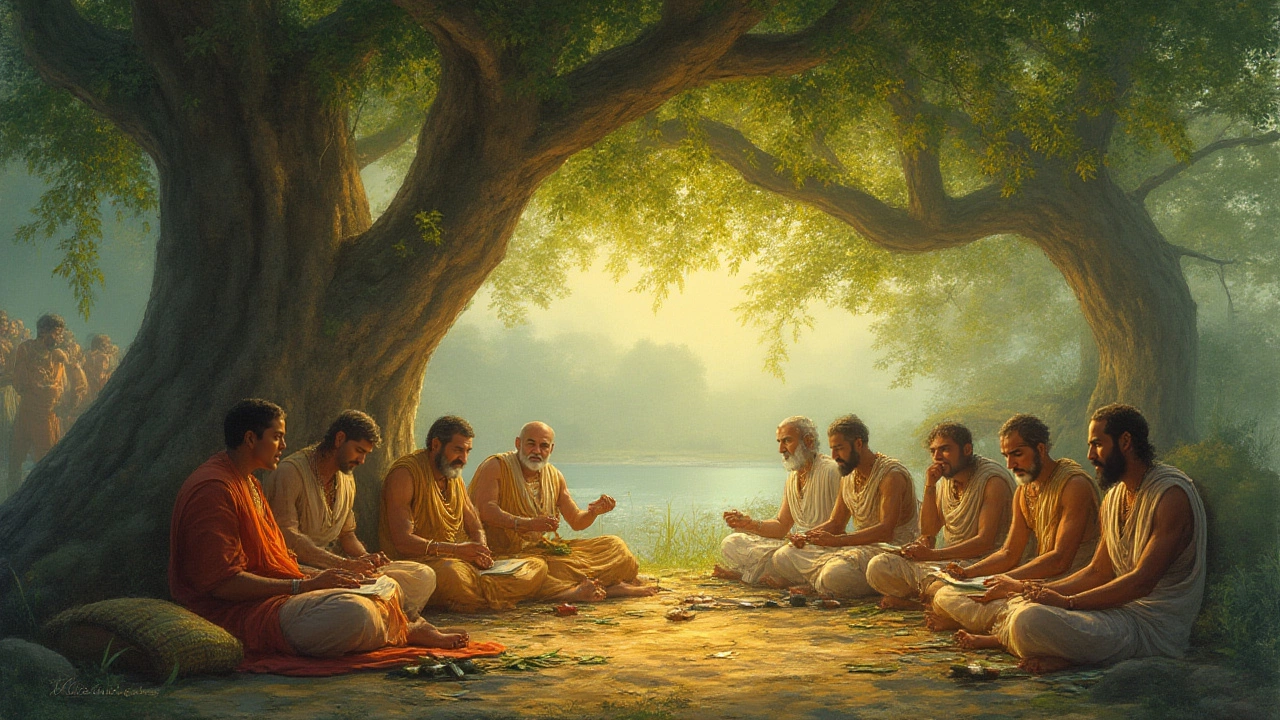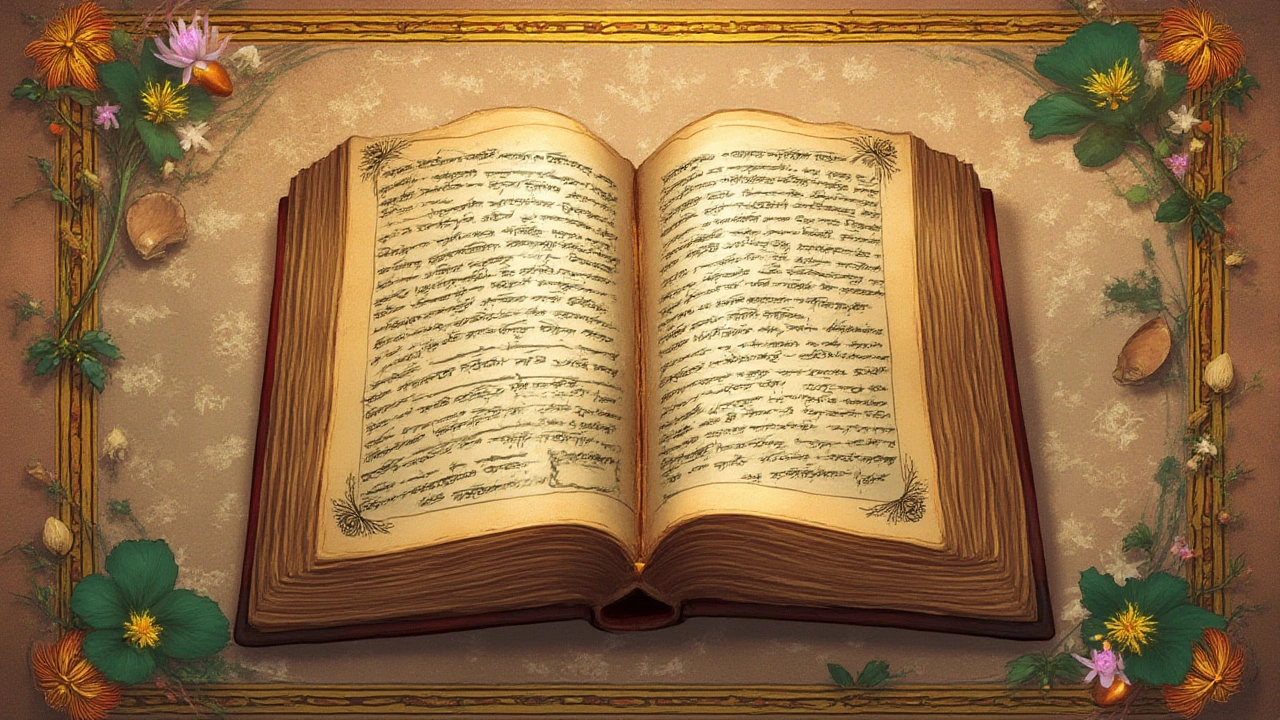
Picture words so old, they're like echoes from humanity's dawn. Some of the earliest poetry wasn’t carved on stone or inked onto scrolls but whispered over sacred fires. Among the oldest, the Rigveda stands out as the grandparent of Hindu poems—a collection still alive and well in rituals and memory today. Some researchers even call it the world’s oldest religious text that’s still in use. Now imagine reciting lines almost four thousand years old and realizing those verses once tied families, tribes, and a whole civilization together. That’s the power old Hindu poetry brings to this day.
What Exactly is the Rigveda?
The Rigveda, also spelled Rig Veda, isn’t just a single poem—it’s a collection of 1,028 hymns (called suktas) penned in Vedic Sanskrit. Most specialists agree the earliest layers date back to between 1500 and 1200 BCE. That’s older than Homer, older than the biblical Psalms, older than most surviving poetry anywhere. People from the ancient Indus Valley and the wider Indian subcontinent would gather as families, passing these chants down like precious family treasures. Back then, there was no writing. Everything was memorized and chanted—so accuracy and rhythm weren’t just literary flair, they were life or death for the words.
Each hymn was dedicated to different deities or natural elements—fire (Agni), rain (Indra), earth, and cosmic forces. There’s a strong fascination with nature, creation, morality, and even doubt and questioning, which is pretty wild for something so old. Remember, the Rigveda isn’t a dusty relic. Practitioners today might still chant a verse called the Gayatri Mantra at sunrise as a daily ritual. It’s got surprising sticking power.
Unlike some later Hindu texts that focus on stories or epic battles, the Rigveda’s poetry is a swirl of metaphors, riddles, and prayers, tightly woven in a kind of musical logic. For example, there are poems that ask the universe how life began, or hymns thanking the rivers for giving life. The collection starts with praise of Agni, the fire god, maybe because every ceremony (from weddings to funerals) started with lighting a sacred fire. This strong sense of tradition carries the text right into the present day, which is remarkable given how long ago it all began.
While the earliest manuscripts only show up around the 10th century CE, archaeological finds and oral traditions confirm that the verses themselves are way older. And the fun part? Each family or priestly group (called shakhas) kept their own way of chanting and interpreting the texts, meaning the Rigveda was a living, breathing poem that shifted with the community.
Here’s something that catches a lot of people off-guard: physics teacher Subhash Kak once showed how the Rigveda seems to encode astronomical knowledge, such as mentions of eclipses, solstices, and lunar cycles—long before modern science gave us the language for it. So these hymns are more than prayers—they’re history, science, music, and philosophy rolled into one.
Take a peek at how some of the text is divided:
| Section | Description | Approximate Number of Hymns |
|---|---|---|
| Mandala 1 | Introduction, general prayers | 191 |
| Mandala 2-7 | Family books, oldest core poems | Each 40-63 |
| Mandala 8-10 | Later additions, cosmology, varied hymns | Each 47-191 |
What survives today from those ancient fire-lit gatherings is a time capsule, voiced in dusty villages and bustling cities alike—proof that some poetry really is forever.
How Did People Remember the Rigveda for So Long?
You might wonder: how did anyone remember all these hymns, thousands of lines, for generations—especially before writing was common? Turns out, the Vedic tradition probably has the most advanced oral memory system in human history. Teachers used all sorts of memory tricks: repeating lines backwards and forwards, teaching syllable by syllable, and using melody as a kind of anchor. Kids as young as six or seven would get up at dawn, sit cross-legged, and chant lines again and again until every word clicked into place.
Sanskrit, the language of the Rigveda, was already pretty special because its sounds are clear and pronounced, which helps with memorizing. Chanting isn’t just recitation here—it's a group act, almost like a team sport. Get a syllable wrong and the group would spot the slip right away. There was no “good enough” in this system; precision mattered because folks believed errors could mess with rituals and, in their eyes, even the cosmic order.
What’s gripping is that these oral systems meant the Vedas were not just memorized but performed. Rhythm, pitch, and timing turned the poems into living music. One family in southern India, the Nambudiri Brahmins, could preserve certain ways of reciting for over a thousand years almost unchanged, and recent linguists who studied them were stunned at the accuracy.
And don’t forget women. While public rituals were male-dominated, several Rigvedic hymns are credited to women sages, called rishikas. Their poems often reflect household life, the struggles and hopes of ordinary people, and, sometimes, mystical insight that’s every bit as profound as the more famous hymns. In fact, the words of poet-saints like Lopamudra are still recited today.
In recent times, linguists have even used the Rigveda’s preserved pronunciation to reconstruct the sounds of a language 3,500 years ago—think of it as an archaeological dig, but for your ears. All these details make this “oldest Hindu poem” not just a dusty book but a living voice that survives one chant at a time.

Why the Rigveda Still Matters Today
So, what’s the big deal with poems written so long ago? Well, the Rigveda isn’t just a religious document—it’s a window into ancient life, questions, and hopes. Themes like creation, sacrifice, longing for peace, and even doubt about the gods appear again and again. That sense of curiosity and honest searching connects us to those first Vedic poets in surprising ways.
Parts of the Rigveda still pop up everywhere: yoga studios chant the Gayatri mantra at dawn, politicians sometimes quote hymns to inspire national unity, and even Bollywood loves slipping a sacred verse or two into songs. The style and structure of Vedic Sanskrit have shaped not just later Hindu texts, but also classical music, dance, and the way people debate philosophy in India.
If you’re into linguistics, the Rigveda is a Rosetta Stone. The text is the earliest example of Indo-European languages, so anyone studying roots shared by Sanskrit, Latin, and Greek will end up dipping into Rigvedic verses. In fact, linguists used Rigvedic grammar and vocabulary to unravel the family tree of languages from Europe to Persia. George Bühler and Max Müller, famous 19th-century scholars, based some of their ground-breaking work on this very text.
Socially, the Rigveda hints at a society that was in flux—nomadic but slowly settling, deeply spiritual but also practical. You see women composing poems, artisans and craftsmen getting songs in their honor, and prayers for rain and health that feel just as urgent today as they did then. There’s even a hymn that prays for mutual respect among people, which must sound familiar to anyone navigating modern life!
For people tracing their roots or wanting to connect with ancient culture, the Rigveda isn’t background noise—it’s a direct line to ancestors. Each ritual, festival, or morning chant that starts with those verses keeps the connection alive. If you look closely, you’ll find bits of Rigvedic wisdom in everyday Indian proverbs, lullabies, wedding songs, and even politics. Old as they are, these poems really don’t feel ancient; they feel like a hand reaching out from the past.
Other Ancient Hindu Poems and Their Stories
The Rigveda might be the crown jewel when it comes to the oldest poems, but it’s not the only ancient Hindu text worth knowing. After the Rigveda, three more Vedas emerged: the Yajurveda, Samaveda, and Atharvaveda. Each one built on the tradition—some focusing on melodies and rituals, others on everyday life’s concerns like health, love, and spells to cure sickness.
Outside of the Vedas, another famous pair of Indian epic poems came centuries later: the Mahabharata and Ramayana. If the Rigveda is earliest, think of these epics as the wild, sprawling novels of the ancient world. The Mahabharata, at over 100,000 verses, is the longest poem ever written, and its most famous chapter—the Bhagavad Gita—continues to be quoted everywhere from philosophy classes to leadership seminars.
But the Rigveda is unique in its age and style. Here are some quick comparisons between key ancient Hindu texts:
| Text | Type | Estimated Age (BCE) | Unique Features |
|---|---|---|---|
| Rigveda | Poetry (Hymns) | 1500-1200 | Oldest, focus on nature/gods |
| Yajurveda | Ritual formulas | 1200-800 | Ceremonial instructions |
| Samaveda | Music/Chant | 1200-800 | Hymns for singing |
| Atharvaveda | Spells/Prose | 1200-900 | Charms, remedies, magic |
| Mahabharata | Epic Poetry | 400-100 | Stories, philosophy, war |
Even today, if you visit a temple in India or attend a traditional Hindu wedding, you’ll catch traces of these ancient poems—maybe in a melody, a chant, or the words that send a newlywed couple on their journey. It’s kind of wild to think these stories and verses outlived empires, technology shifts, and changing languages.
So next time you hear someone chanting in Sanskrit or reciting an old Hindu verse, remember, there’s a good chance those words are far older than most languages, stories, or even cities still around today. The Rigveda and its fellow ancient texts aren’t just poetry—they’re reminders of just how far back our need for meaning, faith, and beauty really goes.